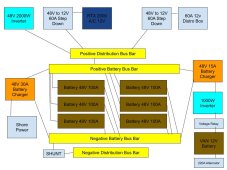Regardless of what voltage you pick, air conditioning a van in FL in the middle of summer is going to use about 1 kW (averaged ) to power it, so:
( 24 hrs / day ) x ( 1 kW ) ~ 24 kW-hrs.
This is a reasonable, tested, first order estimate number that you can use to get in the ball park to see if the rest of your design makes sense or not.
_______________
Just to put this into a physical perspective, it is 24 each, 12 volt, 100 amp-hr, LiFe batteries for 1 day of air conditioning.
It does not matter all that much if you wire these to feed a 12 volt, 24 volt, or via a 120 vac inverter fed air conditioner. Some yes, but it won't change it by 50%. If it is hotter or cooler, more humidity or less will change it a lot, but not so much the air conditioner voltage. If anything, higher voltage to the compressor motor will make it more efficient.
For most people, having this much battery capacity in a van, much less 3x this much - is not really practical.
I will admit that I really like air conditioning and if you are just taking the edge off, you will get longer run time.
____________
So a more practical approach is to have perhaps 8 hrs of air conditioning battery capacity on board, along with something like a honda or yamaha 3000 generator. Every 4 - 5 hrs, turn on the generator and run it for 2 hrs to keep the pack charged up, then try to go all night with it off.




